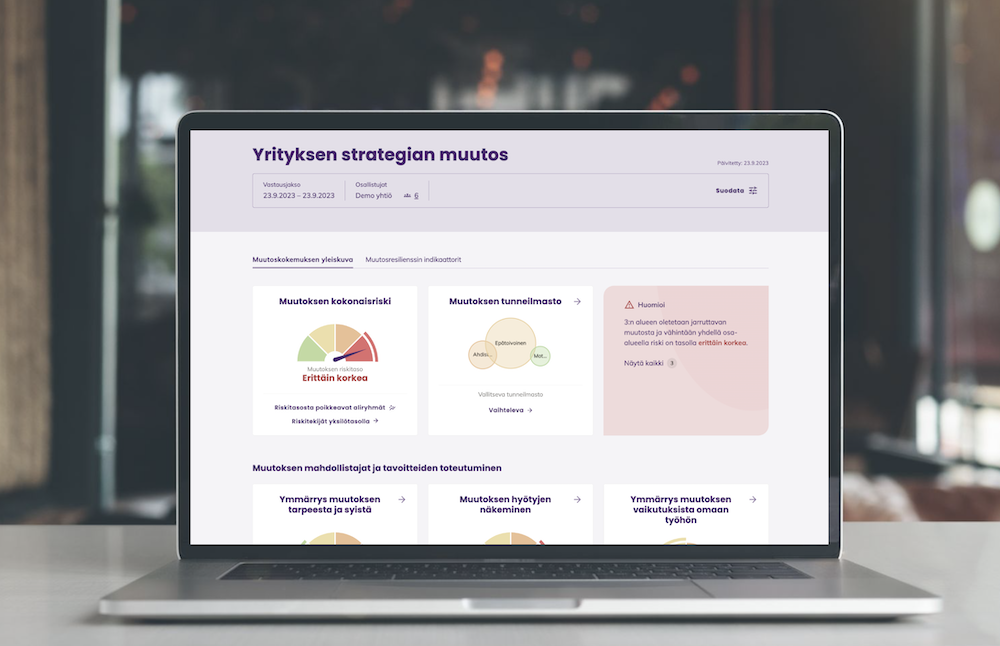
The change experience is a new employee experience.

Do you feel like the same problems keep spinning on the table year after year, even though job satisfaction is measured regularly? In order to address the real root causes of challenges and make impactful solutions at the business level, measuring employee experience alone is not enough. Change experience management is also needed alongside it.
Dissatisfaction is often a symptom of change.
The employee experience survey is an excellent tool for identifying what areas in the organization need attention. However, it is often the case that the dissatisfaction that arises is a symptom of something that happened a long time ago. When the data from the satisfaction survey is finally available, it can be difficult to pinpoint what originally caused the dissatisfaction.
According to our experience, the majority of symptoms of dissatisfaction are caused by situations where some change has been left incomplete: processes are scattered, people have not found a functional way to work with each other, uncertainty and lack of knowledge are brewing, and ultimately we are burdened in the midst of all the chaos.
The background of problems is often changes that have been left unfinished or changes that have not been made, even though they should have been.
It has been a few months or several years since the change, if it is not carried out to the end, the consequences will remain a part of everyday life until their root causes are fixed and the reform is carried out to completion.
Why should change experience be led?
In order to solve the root causes of challenges in employee experience more effectively, we have learned that in addition to traditional methods, new ways are needed to identify and address human challenges. We believe that managing change experience is one of the most effective ways to improve job satisfaction. Why?
1. Matters must be addressed when they are relevant.
In most organizations, a comprehensive employee experience survey is conducted once a year. Often, the fear of staff experiencing survey fatigue is behind this.
Instead of excessive questioning, it would be more important to be concerned about the possibility that something essential is overlooked due to fear of asking. If quiet signals are not detected in time and the clues provided by the survey responses are not immediately seized, the consequences can become even more costly.
When the snowball of problems rolls downhill long enough, it becomes a big avalanche that requires resources from HR and supervisors to be resolved.
Alongside the employee experience survey, it is also worth utilizing constantly lighter methods. It is not always necessary to have organization-wide surveys or measures, but the experience of change can be measured where the risk of fluctuation in job satisfaction is greatest: for example, in a team where key personnel change, in a department that implements a new system, or in a unit that faces change negotiations.
We have seen the benefits that can be achieved with just one or two questions. When the five-minute answering time is incorporated into a team meeting or other regular encounter, the survey does not cause any additional burden.
2. Connecting with business gives meaning to the change experience.
Employee experience surveys are often strongly identified as HR tools. The same challenge also applies to lighter satisfaction, mood, and well-being pulses. For employees, a satisfaction survey is unfortunately often "something extra". Managers may also find it challenging to discuss survey results with their teams if the connection between the issues being asked and their team's daily life is not clear.
If both questions and solutions have a direct link to everyday life, more impactful results can be achieved.
Team members can be surveyed about their trust in the success of a joint project. When the measurement is related concretely to the actions and goals of their own team, it is easier for the respondent to realize that factors such as their own well-being or conflicts within the team directly affect the success of their own group.
3. Teams need tools to support their operations.
It is not enough that the questions themselves are related to the daily life of the teams if the results of the surveys are directed solely to HR. Teams and individuals should themselves receive immediate data about their own situation. When human risk factors are identified, they can be discussed and potential barriers to progress can be identified. Based on the survey results, teams can also be offered action recommendations and concrete low-threshold support services to solve the situation.
When talking about experiences that trigger changes, things may always come up that don't necessarily feel comfortable.
All kinds of human reactions and emotions are, however, a natural part of change, and they should not be feared or taken personally. At best, the observations raised by the change experience survey provide valuable information for supervisors and management on what should be the focus of leadership work.
When teams are provided with tools to identify and solve challenges more independently, the role of HR also changes.
Human challenges are not problems to be pushed onto HR, but rather things that every team must be able to solve in order to succeed in achieving business goals.

A fresh approach and tools are needed.
Measuring the experience of change helps to take a human perspective into account in all business-critical projects. With an employee experience survey, results can be measured over a longer period of time: do symptoms decrease and does job satisfaction improve? At the same time, we learn to better anticipate in which situations changes face risks, and when the terrain is favorable for the success of the change.
Guiding change experience surveys have been involved in supporting various changes, from clarifying team goals to significant system investments and mergers. 100% of our customers have experienced tangible benefits already after the first round. If you have a change project in mind where you would like to try our change experience survey, I am happy to tell you more - you can find my contact information below and I am also happy to network.On LinkedIn
What is Guidin?
The guide is a change management tool that ensures the success of your project by anticipating human risk factors.

Read more

Recognize the emotional climate and lead change more effectively.
4.9.2023Although human factors are now being taken into account more and more in various organizational change situations, there is still one area that often remains outside of systematic examination: the emotions caused by change. Emotions inevitably guide our actions, and therefore it is not insignificant how emotions are recognized and dealt with as part of change.
